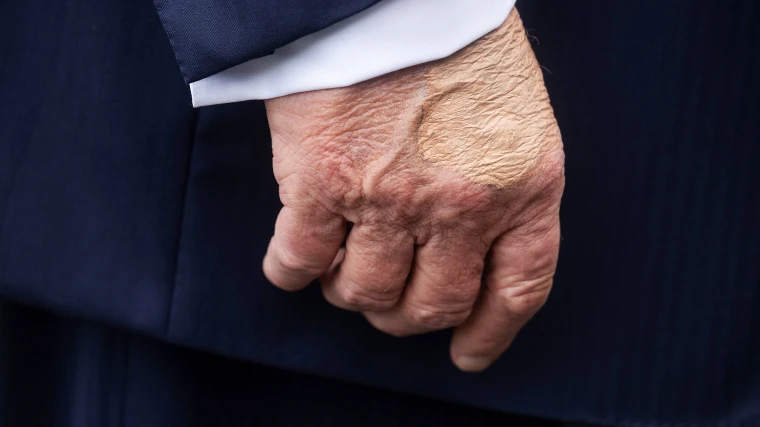Donald Trump’s Chronic Venous Insufficiency Diagnosis: What It Means and Why It’s Not Life-Threatening
Former U.S. President Donald Trump, now 79 years old, has recently been diagnosed with chronic venous insufficiency (CVI) after noticeable swelling in his ankles sparked public curiosity about his health. The diagnosis, which was confirmed on July 17, 2025, came after he underwent a series of vascular tests including Doppler scans and ultrasounds. The White House has assured the public that this condition is benign and manageable, posing no immediate threat to his overall health.
This update follows Trump’s public appearance at the FIFA Club World Cup final on July 13, where images of his visibly swollen ankles circulated online, leading to widespread speculation about his well-being. Let’s explore what chronic venous insufficiency is, why it occurs, and what this diagnosis means for Donald Trump’s health and future.
What is Chronic Venous Insufficiency (CVI)?
Chronic venous insufficiency is a common vein disorder that primarily affects older adults. It happens when the valves in the veins—especially in the legs—become weak or damaged, making it difficult for blood to flow back to the heart. Instead of moving upward, blood pools in the lower extremities, leading to swelling, heaviness, and discomfort.
According to medical experts, CVI is not life-threatening, but it can be uncomfortable and, if untreated, may lead to complications such as skin changes or ulcers. Risk factors include aging, obesity, a sedentary lifestyle, prolonged standing or sitting, and a family history of venous diseases.
Trump’s Diagnosis and Health Evaluation
Trump’s health evaluation was thorough, ruling out more serious conditions such as deep vein thrombosis (DVT), arterial disease, heart failure, and kidney issues. His echocardiogram came back normal, and doctors confirmed that CVI is the only concern, with no signs of systemic illness.
The White House described Trump’s condition as “a common and benign issue” that affects millions of people, particularly those over the age of 70. Additionally, bruises spotted on Trump’s right hand were attributed to minor soft-tissue irritation caused by frequent handshakes combined with his regular aspirin use, which can increase bruising.
What Symptoms Did Trump Experience?
The main symptoms linked to Trump’s CVI diagnosis include:
-
Swelling around the ankles and lower legs
-
Mild heaviness or discomfort in the legs
-
Possible early signs of varicose veins
-
Flaky or slightly discolored skin around the swollen area
Importantly, Trump’s doctors have confirmed that he is not experiencing any pain or significant mobility issues.
How is CVI Treated?
Treatment for chronic venous insufficiency focuses on improving blood flow and preventing the condition from worsening. Common treatment strategies include:
-
Compression stockings to improve circulation and reduce swelling.
-
Regular exercise, particularly walking, to keep blood moving through the veins.
-
Elevating the legs when resting, which helps blood return to the heart.
-
Weight management and maintaining a healthy lifestyle.
-
Minimizing prolonged sitting or standing to reduce pressure on leg veins.
In some cases, medical procedures such as sclerotherapy or vein ablation may be recommended for severe symptoms. However, Trump’s condition appears mild and is being managed with conservative approaches.
What This Means for Trump’s Health
The diagnosis of CVI does not indicate any major decline in Trump’s health. In fact, his medical team reports that he remains in excellent overall condition for his age. The condition is chronic but manageable, and with proper care, Trump is expected to maintain his usual level of activity.
Given that CVI is so common in older adults—especially those over 70—it’s unsurprising that Trump would develop this condition. It does, however, serve as a reminder of the importance of regular check-ups, especially for individuals who frequently stand for long periods or travel extensively.
Public Interest in Trump’s Health
Trump’s health has always been a topic of public interest, and this diagnosis has reignited discussions about how aging might impact political figures. However, experts emphasize that CVI is not a serious disease and is unlikely to affect Trump’s daily responsibilities or future plans.
By addressing the issue publicly, Trump’s team has sought to dispel rumors and misinformation circulating online. The official statement highlights that while his condition requires attention, it is well under control with standard treatments.
The Bottom Line
Donald Trump’s diagnosis of chronic venous insufficiency is a reminder that even high-profile figures are not immune to common age-related health conditions. Thankfully, CVI is neither life-threatening nor debilitating, especially when detected early and managed appropriately.
With conservative treatments like compression therapy and lifestyle adjustments, Trump’s medical team expects him to remain in good health. For the public, this serves as an opportunity to learn about CVI, its symptoms, and how to prevent complications from this widespread yet often overlooked vein condition.









